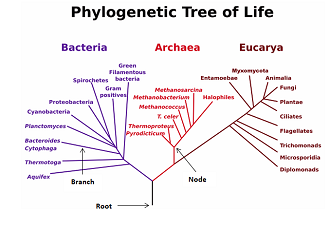Phylogenetics is a topic in biology which analyzes and illustrates the divergence of species and the evolutionary relationships between different groups of species. Phylogenetics is a method of classifying species based on reproductive patterns and also from their derived characteristics. All derived traits trace back to a common ancestor.
Phylogenetics represents a way of connecting all species back to their earliest lineages. Sometimes classifications can be difficult, especially when species which do share evolutionary lineages are phenotypically very different. Phenotypic changes occur over time and cause species to differentiate greatly from each other. For example, birds are descendants of dinosaurs and thus, are phylogentically related, even though phenotypically they are not similar. Furthermore, birds underwent rapid diversification, especially with the development of flight. Although there is a link between birds and dinosaurs, they are separated by classes, with birds having their own class, Aves, and dinosaurs being classified as reptiles.
Phylogenies can be constructed and visually depicted through the creation of phylogenetic trees. These trees act as a hypothesis for the evolutionary relationships existing between species and are prone to change over time as new species are discovered.

Figure 1. This figure presents an example of a phylogenetic tree for the three domains of life. Each domain is separated based on RNA data.
Some of the major structural features of phylogenetic trees have been labelled in Figure 1. Constructing phylogenies gets rather complicated and thus, for the purposes of this discussion the construction of a phylogenetic tree will not be elaborated upon. However, it is important to note that the use of molecular methods such as data sequencing, are incorporated with the construction of phylogenies because they help to identify the similarities between different groups of species. Evolutionary lineages are based on genetic similarities.
© BrainMass Inc. brainmass.com July 26, 2024, 4:35 am ad1c9bdddf